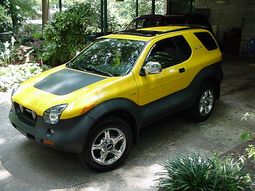The History Of Isuzu Vehicross

The Isuzu VehiCROSS was a halo car for the SUV-specialist company Isuzu. Produced from 1997 (Japanese market 1997-1999) through 2001 (US market 1999-2001), it shared much of its components with the Trooper, including both its 3.2L and 3.5L V6 engine that produces 215bhp (160kW) at 5400 rpm and 230lb·ft (312N·m) at 3000 rpm of torque. The vehicle also featured the TOD (Torque on Demand) 4-wheel Drive system produced by BorgWarner. It is a small, sporty 2-door crossover vehicle with aggressive external styling, including short overhangs, an aggressive forward stance, titanium "teeth" in the grille, a black hood-insert, and black plastic cladding the entire lower half of the vehicle. The VehiCROSS came equipped with 16" polished wheels in 1999 and 18" chrome wheels during the remainder of production.
The VehiCROSS was highly regarded for its cross-terrain performance. It combines a computer-controlled all-wheel-drive system for on-road driving and a locked-differential low gear four-wheel-drive system for off-road driving. Its computer controlled "Torque on Demand" system, with 12 independent sensors detecting wheel spin and redirecting power to the wheels with the most traction, gives the VehiCROSS a high level of traction on wet and icy roads. It also has a high level of performance for its height. While possessing on-road nimbleness, its body-on-frame truck construction, suspension and 4WD gearing made it very capable off-road.
Sales were intentionally limited, with only 4,309 vehicles being produced between 1999 and 2001, and just 4,153 finding homes in the United States in three years of sales. As it stands, the vehicle has an obscure role in history; although, the vehicle appeared in the 2000 film Mission to Mars as a convertible fitted with futuristic engine sound effects.
Upon its unveiling at the 1993 Tokyo International Auto Show and ultimate Japanese production release in 1997, the VehiCROSS was a design ahead of its time. It was the first time that a Japanese automaker had brought a concept vehicle to production with so little design changes and in so short a time (accomplished through the use of inexpensive ceramic body-stamping dies and the reuse of readily-available Isuzu parts). The truck was intended to showcase Isuzu's off-road technology, exemplified by the monotube shocks with external heat-expansion chambers (technology normally reserved for off-road motorcycle racing).
Motor Trend featured the VehiCROSS on its May 1999 cover, and included it in its "Top 10 Sport Utilities" for Most Unique Styling.
Four Wheeler featured the VehiCROSS as the "First Runner Up" for Four Wheeler of the Year in 2000 behind the Tahoe Z71; when pitted against: Chevrolet Tahoe Z71, GMC Yukon, Nissan Xterra, Ford Excursion and Mitsubishi Montero Sport. The VehiCROSS scored highest of all 6 Mechanically, for Trail Performance and Highway Performance.
Both a concept four-door version (VX-4) and a roadster (VX-O2) were shown at the 2000 Los Angeles International Auto Show, but neither reached production.
Led by Satomi Murayama, chief designer/ manager at Isuzu's European office in Brussels, the design team was comprised of an international group: Simon Cox (Assistant Chief Designer best known for designing the Lotus Elan's interior), Joji Yanaka, Andrew Hill and Nick Robinson. The task was to build a "lightweight but tough, fun but environmentally friendly" SUV.
- Winner of the 1999 Russian Spirit of Time Award by the Russian Design Confederation (presented to Isuzu at the 1999 Russian International Motor Show).
- Class Winner 1998 Paris-Dakar Rally
- Class Winner 1999 Australian Safari Rally
- Winner "Most Unique [sic] Styling" Motor Trend 1999 Top 10 Sport/ Utes
- Used by Austin Robot Technology as foundation for robotic VX in 2005-2007 DARPA Grand Challenge
From Wikipedia, the free encyclopedia
More About Isuzu Vehicross

|